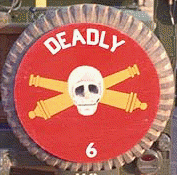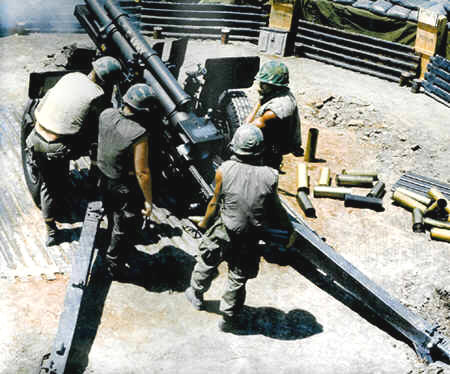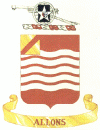Vietnam
War - 6/15th
15th Field Artillery
Regiment
INDIANHEADS
Vietnam War - 6/15th
"Deadly"
The 6th
Howitzer Battalion (105mm) (Towed), 15th Artillery,
was reactivated at Ft. Sill, Oklahoma, 1 December 1966, specifically to provide additional
fire support to the 1st Infantry Division. The Battalion Commander was LTC Frank E.
Serio.
On 1 May 1967, the Division departed Ft. Sill for Vietnam via rail and aboard the ship
USNS Gordon. Division Headquarters was established 26 May 1967 at Lai
Khe.

On 17 October 1967, 2nd Lt. Harold B. Durham, Jr. distinguished himself by conspicuous gallantry while assigned to Battery C, 6th Battalion, 15th Artillery. 2nd Lt. Durham was serving as a forward observer with Company D, 2nd Battalion, 28th Infantry during a battalion reconnaissance-in-force mission. 2nd Lt. Durham's gallant actions in close combat earned him the Congressional Medal of Honor, but cost him his life.
On 28 July 2000, the 2nd Bn, 15th FAR, located at Fort Drum, NY, dedicated their Headquarters Building as Durham Hall in honor of 2nd Lt. Harold "Pinky" Durham. Additionally, an M102, 105mm Howitzer was named "PINKY" in honor of 2nd Lt. Harold "Pinky" Durham, complete with 6th Bn, 15th FA bumper markings.
The 6th Battalion, 15th Artillery participated in most of the 1st Infantry Division's major battles under the call sign "Deadly". The men distinguished themselves at Quan Loi, Da Yeu, Ong Thanh, Loc Ninh, An Loc, Srok Rung, Xa Cat, Tong Le Chon, Bu Dop, Hill 172, and numerous others. The 6/15th served in nine major campaigns from May 1967 to November 1969:
Counteroffensive, Phase
II
Counteroffensive, Phase III
Tet Counteroffensive
Counteroffensive, Phase IV
Counteroffensive, Phase V
Counteroffensive, Phase VI
Tet 69/Counteroffensive
Summer-Fall 1969
Winter-Spring 1970
"Deadly" gained a reputation throughout the Division for being quick,
accurate, and deadly.

A-6-15th FA firing in
support of the US Special Forces
near the Cambodian Border at Katum 1969
Photo:
The Field Artillery School and Mac McGuffin
The
Fire Mission
By Jim
Carlina
A Tribute to an Artillery Battery
Battery
Adjust!
Where were they headed?
Carriers of a piece
of the end for someone.
Now fire G.I., yes fire
At our command,
fuse timed, fuse quick.
shell HE and WP
Or spread them out,
A thousand little darts
One for each Gook
Who doesn’t knock.
Let them go,
One hundred rounds more.
Getting closer to the end of this war.
Clanking
of spent canisters
thrown in the rubble.
More boxes of ammo,
the cure for this trouble.
Don’t cut a wrong charge,
And send a short round.
Don’t want to hit friendlies,
Taking enemy ground.
Forced
to kill V.C.;
they are not people.
They all have one name,
Its Charlie.
And Charlie is out there,
So they said.
We can’t see him.
Don’t know if he is dead.
FDC
only says,
Now cease fire G.I.,
And clean up the mess.
Left wonder about our success.
THE DEFENSE OF SAIGON
To
accomplish this unusual mission, the Battalion placed personnel with
optical instruments and prefabricated aladades on the tops of tall
buildings and in towers throughout the city A counter rocket and
mortar program consisting of known and suspected launch sites was
quickly developed and disseminated to all clearing agencies.
To decrease
reaction times to an attack, the Battalion employed the technique of
“quick reaction targets” which it had initiated at Lai Khe and Phouc
Vihn. Aerial surveillance corridors were also established and all
radars in the area were given pointing azimuths to insure optimum
and maximum coverage of rocket areas around Saigon. Everything was
“wired in” to the BOE.
Upon its
release from CMAC to resume its more tradition Field Artillery
mission in III Corps, the Battalion was commended for its
outstanding performance of duty in the destruction of the enemy’s
capability to harass and terrorize the people of the city of Saigon
during Tet 1968 by MG John B. Hay, CG, CMAC.
Anonymous.
Hellfire Herald, 6th Bn, 15th FA, RVN, 30
August, 1969
THE GUN CREW
These men
live and work together 24 hours a day. When a fire mission is called
these men make one of the finest, most organized teams in the Army.
They know their jobs and they realize that lives depend on their
speed and accuracy. The deflection and quadrant elevation must be
set correctly; the bubbles must be leveled; the fuzes must be set
correctly; the number of powder bags must be correct. Everything
must be correct if the round is to be accurate, on time and on
target. Lives may depend on it! When the entire battery is firing,
the rivalry and tension can be felt between each gun crew.

6/15th LINKS
2LT Durham - Medal of Honor
"The
work for giants... to serve well the guns!"
Walt Whitman
